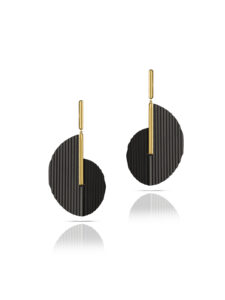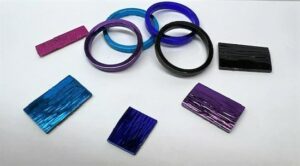Plating
Gold Plating, Silver Plating, Rhodium & Precious Metal Plating
At Elliot-Fitzpatrick we offer a variety of precious metal plating services and use electroplating to provide a long lasting and hardwearing finish each time. Our yellow gold tanks are made up of an almost pure gold solution(23.7ct). The gold we use in our tanks is recycled; however other chemicals are added to the plating solution so we cannot guarantee it is 100% recycled. In addition to gilding, we can accurately control the thickness of our gold plating with normal applications ranging from 1– 5 microns in thickness (hard gold plating). Gold vermeil plating is a minimum of 2.5 microns or above and we can plate up to a maximum of 10 microns.
 We currently offer the following Precious metal plating options:
We currently offer the following Precious metal plating options:
- Yellow gold (23.7ct)
- Rose gold (18ct)
- Silver
- White Rhodium
- Black Ruthenium
Coloured plating

As well as precious metal plating we are one of the only companies in the UK to offer coloured Nanoceramic plating. Our colours currently include Black, Turquoise, Fuchsia, Blue and Violet with more colours available soon.
The cutting edge Nanoceramic coating is more durable and hardwearing than normal Ruthenium and precious metal plating, which makes it great for rings. Due the thickness of this plating we would not recommend it for chains or items which contain moving parts.
Selective plating
In addition to our standard plating we are also able to offer partial plating and multi-finish plating. ‘Masking or stopping off’ is done by hand and this enables us to plate only certain areas or introduce multiple colours to one piece. We are able to ‘stop off’ extremely intricate detailing or larger areas so get in touch to discuss your requirements.
Preparation, Cleaning and Aftercare
Plating is the final process and should be done once all soldering/ assembly has taken place and the item has been polished/ finished to the required standard. Plating will not change the surface finish of a piece only the colour, so any areas that are matte, polished etc will remain the same after the piece has been plated.
Before the items are plated, they undergo a cleaning process to remove any grease or residue from the surface. Both the cleaning and plating process involves the item being submerged in a heated solution. Due to this some stones (Lapis, Malachite, opals, Coral, turquoise, pearls etc) and enamels can be affected or damaged during the process. Whilst we take extra care when plating, these items are plated at the customers own risk and we are unable to accept responsibility for any loss or damage that occurs.
Over time plated items can become discoloured or tarnished, when not being worn or used so we recommend storing the items in acid free tissue paper or an air tight container. Exposure to perfumes, aftershaves, creams, chlorine, acids in skin, cleaning products, hand sanitisers etc can all effect the plating. If the item becomes tarnished or discoloured, try cleaning it with a soft polishing cloth or in warm water with a little bit of washing up liquid. Do not leave in the water for too long and dry with a soft cloth by hand.
Frequently Asked Questions
What’s the difference between a flash plate and hard gold plating?
Flash plating is when a very thin layer of gold is applied to the surface, this is used to colour the piece and can be used on samples, it is not very hard wearing. Hard gold plating is when layers of gold are applied to the surface of the metal. The thickness is measured in ‘microns’ and we would recommend no more than 10 microns.
How long will the plating last?
As with all plated items the plating will eventually wear off over time. As there are various factors which contribute to the longevity of the plating we are unable to guarantee exactly how long it should last. In theory the thicker the plating the longer it should last.
How many microns should I have?
This is down to personal preference. However, if you are wanting to advertise your items as gold ‘vermeil’ they needed to be plated in a minimum of 2.5 microns or above. As a guide we usually recommend:
- 1-2 microns on Earrings and Brooches
- 2-3 microns on Necklaces, pendants, chains and bracelets
- 3-5 on Rings, Cufflinks, Bangles
Can you plate all metals?
Plating works best on precious metals however we are able to plate certain base metals such as brass, copper and gilding metal. Metals such as Stainless Steel don’t tend to plate well and can flake off unless they have been pre-treated.
How much does it cost?
The majority of our Silver and Gold plating pricing is calculated on surface area and varies depending on how many microns the item is plated with. The higher the microns the more expensive it will be. White Rhodium, Black Ruthenium and Coloured plating is priced on a piece by piece basis. In order to provide an accurate quote, we ideally need to see the item in person. If this is not possible you can email a detailed photo along with the items dimensions and the requested microns to enquiries@elliot-fitzpatrick.com (All quotes are subject to change upon receipt of goods and are valid for 30 days) Please note we are unable to quote for items without seeing them. We have a minimum charge of £25+ vat (excluding postage)

